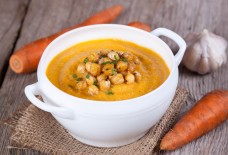A Brief Window into Yemen
Photo Credit: Phil MarionBy: Haneen Abu Al Neel/Arab America Contributing Writer
Every Ramadan, we invite over about thirty people from both sides of the family. Flocks of young children, teenage cousins, and older aunties and uncles are greeted at the door with a smile and a “Ramadan Kareem! Ahla w Sahla”. While I would like to believe that my irresistible humorous hosting skills are the reason, I cannot ignore that my mother’s famous chicken soup is what gets more compliments. My sense of humor is a close competitor, though.
Long after the guests are gone, I sneak into the kitchen to see if any soup is left. More often than not, it has entirely vanished. After I have gotten old enough to be trusted with the family heirlooms, I have come to learn that the secrets of my mom’s soup were in a transparent nylon bag in one of the cabinets. It’s the Yemeni spices she gets from her friends or very trusted herb merchant from the souk. At last, I have unlocked the motherly cuisine wisdom!
For anyone who has eaten their way through the Arabian peninsula, it is unsurprising that we use rich mixed spices for our soups. Yemen, in particular, is known for soups (the colloquial name is Maraks) and hot spices. While I have never been to Yemen, I have had the pleasure of knowing Yemenis and their hospitality. Be assured that when you meet one, you will be well fed with spicy every-single-dish.
The attachment that Yemen has to spices comes from its gulf access, and more importantly, location on the ancient maritime Silk Road from China & India. It is also why Yemen enjoys a colorful selection of Indian influenced main dishes, like Mandi and Saltah. The ubiquitous Yemeni spice mixture is called Hawaij, which is made of fennel seeds, aniseeds, ginger, cardamom among other additions. I won’t claim I know what is in there, that is grandmother level cuisine knowledge.
Though Yemen was still a hot spot for trade due to its versatile ports, the Silk Road made it a constant stop up until the Ottoman Empire cut ties with the Chinese around the mid-15th century. When the Silk Road was still active, it stopped in Aden in Yemen. Aden in Arabic is another name for heaven or eternal resting. Stories of queens and kings, like the story of Queen Sheba, remain alive in the recent memory of Yemen.
Much of the charm of ancient civilizations in Yemen remains present today as ruins in Hadhramaut, Aden, and Sanaa. If you have an appetite for more unique tourist attractions, Yemen enjoys mysteriously diverse bio-diversity on its Socotra Island. Trust me, google Socotra’s Dragon Blood Trees and Bottle Trees. You’re welcome.
Due to some historical and political tensions, Yemen was split into two states, North Yemen and South Yemen. Most people are familiar with the history and formation of North Yemen, but few are acquainted with the Marxist history of South Yemen. After realizing the sheer power of the critical port city of Aden, the British decided to take over–as the Brits did in the 1900s.
The 1960s in Yemen were brutal, dredged with military rebellion and a civil war that went on for six-years and lead to the declaration of the People’s Republic of Southern Yemen in 1967. But, this is not History Channel, so I will keep the history chatter to a minimum. Just after this last point, South Yemen adopted much of its Marxist beliefs and socialists movements from the heavy Moscow influence, evident by its transition to the Marxist People’s Democratic Republic of Yemen in 1970. Eventually, the civil unrest between the North and the South was resolved by the unification of the two sides, and the announcement of Ali Abdullah Saleh as president in 1990.
Much of its 20th-century unrest is mirrored today in Yemen’s humanitarian crisis, where numerous children battle hunger and cholera every day. Yemen was once a stable, thriving civilization, booming with innovation and fascinating history waiting to be told. While we enjoy learning about it from the safety of our homes on the internet, we must never forget to keep an eye on their news. As we anxiously watch the various analyses of the current situation pointing to foreign interference with Yemen’s stability and foundations, we will continue to pray for peace in Yemen and remember its glorious past and the great characteristics of its people.



